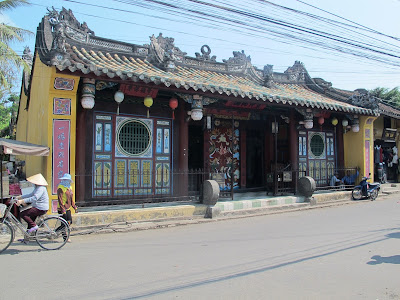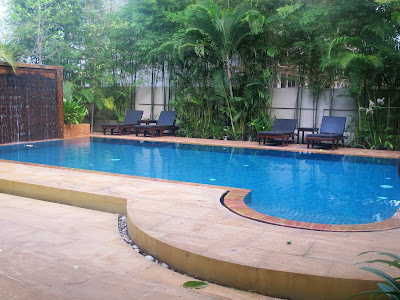Independent travel to South America
Throughout most of the South America, Spanish is the spoken
language and English speakers are very much in the minority. This could have
made travel difficult but despite having a vocabulary of just a few Spanish
words we had no problems at all in organising our trip, getting around once we
had arrived, buying food or gifts, or generally feeling at ease.
Travellers have three different ways to plan travel. Many prefer the security of a tour with
pre-arranged accommodation, transfers and tourist site visits. Others,
especially young travellers, book their flights before they leave home and then
make all their other arrangements after they arrive at a destination country.
We took the third option, and made most of our travel and accommodation
bookings independently prior to departure, leaving most of our time clear to do
as we wished after our arrival.
By travelling independently we had the choice of deciding
how long to stay in each area or town, what type of accommodation to use in
each of those places and whether to fly between towns, or travel overland. We
still had the option of using local tour agencies for short tours of local
attractions, such as a two day tour from Arequipa in Peru to see the condors in
the Colca Canyon. This Colca trip also gave us the choice of travelling on a
bus with many others, or paying more and travelling with just a few others by
car with a guide and driver. We opted for the latter, and ended up as the sole
travellers which allowed our guide to tailor everything to our requirements.
South America is a fascinating continent that offers a
relatively inexpensive destination to stay and travel through. Thanks to the
Internet it is an easy place in which to make independent travel arrangements
before leaving home. We looked for quieter hotels so we could sleep well and
enjoy each day of our trip, and places that were close to the tourist sites. We
decided against long treks such as hiking the Inca Trail which, despite being
reasonably fit, we would have found very testing in the high altitudes.
So how did we do it? Planning a trip for us is half the fun,
and we started thinking about which places to visit about six months before
leaving, raiding the local library of as many tour guides as we could find to
read about possible destinations. This also helped us to choose which guide
books to buy and take with us on our trip. (To reduce the weight in our bags, we
ripped pages out of the books we bought). We chose the Lonely Planet guides to
buy. The Internet provided a great deal of information, including the chance to peek at
where the various tour companies visit as they are likely to centre on the main
tourist attractions.
Early bookings meant lower prices, and certainly a greater
chance of obtaining a first choice of accommodation, so it was important for us
to have plenty of time to decide where to go and what to see.
Our eventual choice was to stay for several days in places
such as Arequipa and Cusco in Peru, Iguazu Falls on the Brazil/Argentine border
and then nearly a week in Buenos Aires, rather than keep on the move every day
or so. So while we would have liked to explore the Lake Titicaca region in
Peru, travel to La Paz in Bolivia, the Galapagos Islands and parts of the
Amazon, time constraints meant that we had to drop those plans. Apart from an
overnight stay to make a flight connection we decided to avoid Peru’s main city
of Lima altogether because of its size. As a couple we prefer to explore
locations on foot as much as we can, which helped in deciding which towns and
cities to visit.
Five months prior to travel we made our flight bookings. We looked
at various airline websites and found that LAN had a South American Airpass
that we could use, providing we travelled to the continent on a LAN flight. This
saved hundreds of dollars on airfares. When it came to actually booking the
flights however, we found in this case it was cheaper to use a travel agent
rather than directly with the airline. (For some reason the quoted price on the
LAN website for the return flight from Auckland to Santiago in Chile fluctuated
greatly from day to day). While we have used an on-line travel agent (Expedia) in the past, our eight separate
flights proved too much for their search engine so our local United travel agency made the flight bookings
for us, along with a couple of airport hotels where flight connections times
required an overnight stay.
Once the flights were in place we made the rest of the
advance bookings. For us these included all our accommodation, two day-long bus
trips in Peru, the tour to see the condors, and rail and entrance fees to Machu
Picchu where their website states that they limit visitor numbers each day. Travellers’
blogs on the Internet provided plenty of advice on what to see and how to
arrange things. We sought hotels that were within easy walking distance of the
main centre, while offering a quiet place to sleep and also were within our
price range. Travellers reported that many of the cheaper hotels and hostals in
Peru sometimes didn’t have hot water for showers, so we avoided those places.
Traveller ratings and comments on various hotels and
apartments on the Trip Advisor website proved very accurate. The comments allowed
us to know in advance that while our inexpensive Arequipa hotel served a rather
skimpy breakfast, it did have a great garden for those afternoon siestas, and
that it was relatively quiet and just a ten minute walk from the central plaza.
Similarly while the hotel we moved to on the Argentine side of the Iguazu Falls
was well priced and had a lovely setting completely enclosed by jungle, we knew
that they charged outrageous amounts for bottled water. In typical kiwi fashion we managed to
circumvent that by buying our water elsewhere at about a tenth of the cost.
We decided have a real splurge for one night at a hotel
within the Brazilian National Park at the Iguazu Falls, which gave us a chance
to wander along the paths next to the falls before the park gates opened in the
morning. Then to balance our budget we found an excellent low cost central
apartment for our six night Buenos Aires stay. Apartment living gave us the
opportunity to live in a 1920s building in the centre of the downtown area and
the freedom to decide whether to self-cater or eat out.
We also found that we could get really good deals by booking
the “luxury” rooms in cheaper hotels. We stayed for six nights in a huge three
room suite in a 3 star hotel in Cusco, Peru, for much less than the cost of an
ordinary room in a 4 star hotel elsewhere in the city.
A few minutes spent on the Internet showed that sometimes it
was cheaper to make bookings directly with a hotel, but alternatively on other
occasions Expedia offered the best
prices, so we booked accordingly. One unusual aspect of travel in Peru is that
many of the hotels do not take credit cards, and so even when bookings are made
through a travel agency, no actual money changes hands until payment is made in
local currency on arrival at the hotel. Fortunately ATM machines, and places
where US dollars can be easily changed at good rates to Peruvian soles, are
found everywhere in the major centres in Peru.
As the accommodation bookings had been made four or five
months prior to travel, and we wanted to make sure that we were still expected
on arrival, we sent an email to all of the hotels a couple of weeks prior to
travel confirming our bookings. All responded, most of them offering to arrange
a taxi to transfer us from the airport or bus station when we arrived.
Some parts of the trip, such as the means of travel across
the border at Iguazu Falls and between Cusco and the village of Ollantaytambo
in Peru, where we spent two lovely days either side of our trip to Machu Picchu,
we did not arrange until we had arrived at our local hotel. However we were
fully aware of the various options, and the costs, thanks to Internet searches
prior to travel.
Before we left home, we had expected to use some of the
local half or full day tours on offer in some of the cities we visited, but
instead found that it was generally easier to visit the places on foot and then
use an internal guide to show us around places such as the centuries old Santa
Catalina convent in Arequipa . Similarly, for less than the cost of an
organised day tour, through our Cusco hotel we hired a taxi to take us from
Cusco to Ollantaytambo, stopping for two or three hours in Pisac to visit the
Inca ruins, travel through the market and have lunch.
On all of the sites we visited, as we were not on an
organised tour we could decide how long to stay. Most of the Inca sites in Peru
are built on fairly steep hillsides which, coupled with the high altitudes,
made clambering through the ruins quite exhausting at times, so we were able to
rest on ancient rocks and catch our breath while enjoying the views, and gaze
at the large groups of guided tourists being rushed through the monuments. The
same applied to our walking trips through the towns. We were free to sit in the
plaza and do a spot of people watching, wander through the streets and see the
local markets, or visit churches or museums as we wished.
Although we were travelling independently we were still able
to meet fellow travellers at breakfast and at other places where tourists
tended to congregate, so that ideas could be exchanged. One such encounter gave
us the name of a good guide, Edwin, to seek out when we visited the Pisac
ruins.
As we had no group constraints about our plans for each day we
had the ability to change them as we travelled. My wife Lyn had some trouble
with altitude sickness in Peru, so we were able to take things a little easy in
the high altitudes without the worry of possibly inconveniencing other
travellers.
Before leaving New Zealand we had printed off the names,
street addresses and phone numbers of all the places where we were staying that
proved useful in helping taxi drivers decipher our mangled attempts at Spanish.
Despite being the same distance from New Zealand and North
America, and not much further from New Zealand as most of Asia, relatively few
New Zealanders tend to visit South America. While potential language
difficulties may put some people off, they caused us no problems. Travel in
South America exceeded our expectations and by organising our own trip, we also
spent about half of price of many escorted tours.
John and Lyn Potter
paid for their own travel to South America.
 |
| Colca Canyon |
 |
| Beef Restaurant Buenos Aires |
 |
| Arequipa Convent |
 |
| Dog Walker, Buenos Aires |
 |
| Iguazu Falls |
 |
| John & Lyn, Puerto Iguazu |
 |
| Machu Picchu |
 |
| Peruvian women with lambs |



















































